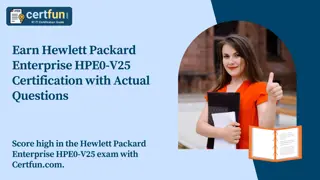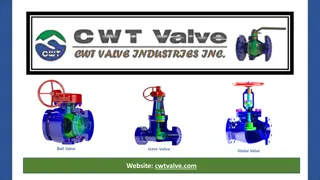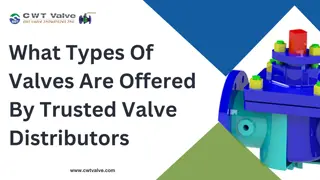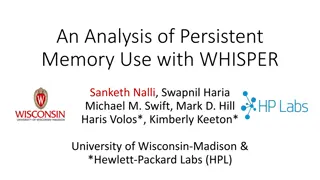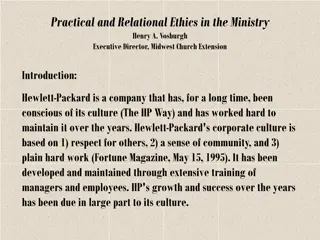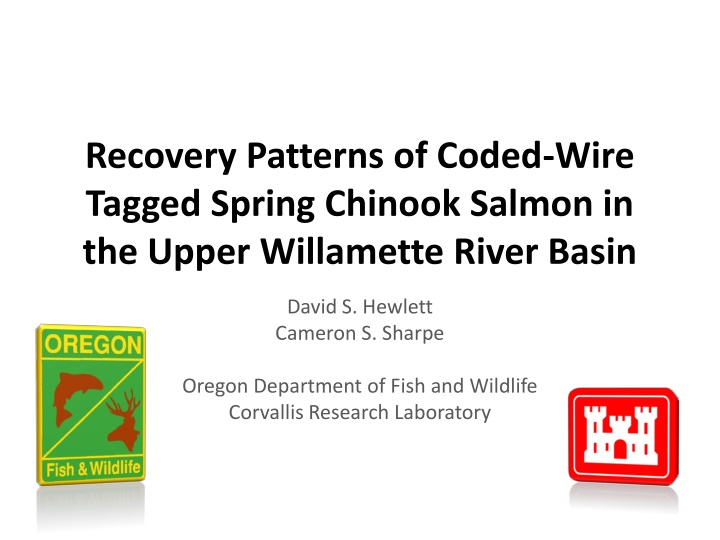
Recovery Patterns of Coded-Wire Tagged Spring Chinook Salmon
This study investigates the recovery patterns of coded-wire tagged spring Chinook salmon in the Upper Willamette River Basin. The research focuses on the impact of release timing on adult returns, concerns about straying at UWR hatcheries, and objectives related to calculating smolt to adult returns, estimating age structures of returning adults, and determining homing/stray rates. Various hatcheries in the region are studied to understand the behavior and migration patterns of these tagged salmon.
Download Presentation

Please find below an Image/Link to download the presentation.
The content on the website is provided AS IS for your information and personal use only. It may not be sold, licensed, or shared on other websites without obtaining consent from the author. If you encounter any issues during the download, it is possible that the publisher has removed the file from their server.
You are allowed to download the files provided on this website for personal or commercial use, subject to the condition that they are used lawfully. All files are the property of their respective owners.
The content on the website is provided AS IS for your information and personal use only. It may not be sold, licensed, or shared on other websites without obtaining consent from the author.
E N D
Presentation Transcript
Recovery Patterns of Coded-Wire Tagged Spring Chinook Salmon in the Upper Willamette River Basin David S. Hewlett Cameron S. Sharpe Oregon Department of Fish and Wildlife Corvallis Research Laboratory
Introduction Methods Results Summary Questions Goals: 1. What impact does release timing have on adult returns? 2. Is straying a concern for UWR hatcheries? Objectives: 1a. Calculate smolt to adult returns (SARs) 1b. Estimate age structure of returning adults 2. Estimate homing/stray rates
Introduction Methods Results Summary Questions RMIS* query Willamette releases and recoveries AD & CWT ChS only 221,970 recoveries of 1,089 releases Filter: Brood years 2000-2008 Standard release/recoveries: Standard release location Recovered at target hatchery Nov., Feb., Mar., and Apr. release timing 11,011 recoveries of 107 releases *Regional Mark Information System (RMPC.org)
Introduction Methods Willamette basin SARs Results Summary Questions = N 43 tag codes ~4000 recoveries Brood years 00-08 Run years 03-13 4 hatcheries Mainstem releases Recovered at target hatchery Released in March
Introduction Methods Willamette basin SARs Results Summary Questions
Introduction Methods Results Summary Questions South Santiam Hatchery SARs
Introduction Methods McKenzie Hatchery SARs Results Summary Questions
Introduction Methods Results Summary Questions Goals: 1. What impact does release timing have on adult returns? 2. Is straying a problem for UWR hatcheries? Objectives: 1a. Calculate smolt to adult returns (SARs) 1b. Estimate age structure of returning adults 2. Estimate homing/stray rates
Introduction Upper Willamette basin age structure of CWT spring Chinook salmon by release timing, brood years 2000-2008 Methods Results Summary Questions
Introduction Upper Willamette basin age structure of CWT spring Chinook salmon by release timing, brood years 1990-2008 Methods Results Summary Questions
Introduction Methods Results Summary Questions Goals: 1. What impact does release timing have on adult returns? 2. Is straying a problem for UWR hatcheries? Objectives: 1a. Calculate smolt to adult returns (SARs) 1b. Estimate age structure of returning adults 2. Estimate homing/stray rates
Introduction Methods Results Summary Questions RMIS query Willamette releases and recoveries AD & CWT ChS only 221,970 recoveries of 1,089 releases Filter: Brood years 2000-2008 Std. release timing (Nov., Feb., Mar., and Apr) All releases and recoveries of UWR reared ChS 32,266 recoveries of 167 releases Classified recovery locations by type/subbasin Migratory fisheries, hatcheries, spawning grounds
Introduction Methods Results Summary Questions Final disposition of coded wire tagged upper Willamette spring Chinook salmon for brood years 2000-2008, by hatchery and release location Same Subbasin Spawning Grounds Out of Subbasin Stray Target Hatchery Migratory Fisheries Hatchery Release Location Marion Forks Detroit Reservoir 22% 68% 4% 6% Marion Forks North Santiam R. 45% 51% 2% 2% South Santiam South Santiam R. 35% 60% 4% 1% McKenzie McKenzie R. 47% 50% 2% 0% Dexter Ponds Middle Fork Willamette 51% 49% 1% 0% Willamette Middle Fork Willamette 46% 53% 1% 0% Willamette Blind Slough 0% 97% 0% 2% Willamette Clackamas River 39% 57% 3% 1% Willamette Molalla R. 0% 82% 1% 17% Willamette South Santiam R. 23% 70% 6% 1%
Introduction Methods Results Summary Questions Stray rates of coded wire tagged upper Willamette spring Chinook salmon for brood years 2000-2008, by hatchery and release location Target Hatchery and Migratory Fisheries Hatchery Release Location Stray Marion Forks Detroit Reservoir 90% 10% Marion Forks North Santiam R. 96% 4% South Santiam South Santiam R. 95% 5% McKenzie McKenzie R. 98% 2% Dexter Ponds Middle Fork Willamette 99% 1% Willamette Middle Fork Willamette 99% 1% Willamette Blind Slough 97% 3% Willamette Clackamas River 96% 4% Willamette Molalla R. 83% 17% Willamette South Santiam R. 93% 7%
Introduction Methods Results Summary Questions Goals: 1. What impact does release timing have on adult returns? No impact on SARs at basin level Variable impact on SARs at subbasin level Fall/sub-yearling releases return younger than spring/yearling releases 2. Is straying a problem for UWR hatcheries? Not for standard releases Potential for unacclimated releases
Introduction Methods Results Summary Questions New questions: Does age impact recovery rate? Does hatchery age structure mimic wild populations? How does release timing impact stray rates?
Introduction Methods Acknowledgements Micki Varney Marc Johnson Results Summary Questions Questions
Introduction Methods Results Summary Questions Final disposition of coded wire tagged upper Willamette spring Chinook salmon for brood years 2000-2008, by hatchery and release location Same Subbasin Spawning Grounds Out of Subbasin Stray Target Hatchery Migratory Fisheries Hatchery Release Location Marion Forks Detroit Reservoir 22% 68% 4% 6% Marion Forks Klaskanine R. 0% 94% 0% 6% Marion Forks North Santiam R. 45% 51% 2% 2% South Santiam South Santiam R. 35% 60% 4% 1% McKenzie McKenzie R. 47% 50% 2% 0% Dexter Ponds Middle Fork Willamette 51% 49% 1% 0% Willamette Middle Fork Willamette 46% 53% 1% 0% Willamette Blind Slough 0% 97% 0% 2% Willamette Clackamas River 39% 57% 3% 1% Willamette Fall Creek 25% 71% 3% 1% Willamette John Day R. 0% 94% 0% 6% Willamette Molalla R. 0% 82% 1% 17% Willamette South Santiam R. 23% 70% 6% 1% Willamette Tongue Pt. 0% 98% 1% 1% Willamette Youngs Bay 0% 100% 0% 0%
Introduction Methods Results Summary Questions Stray rates of coded wire tagged upper Willamette spring Chinook salmon for brood years 2000-2008, by hatchery and release location Target Hatchery and Migratory Fisheries Hatchery Release Location Stray Marion Forks Detroit Reservoir 90% 10% Marion Forks Klaskanine R. 94% 6% Marion Forks North Santiam R. 96% 4% South Santiam South Santiam R. 95% 5% McKenzie McKenzie R. 98% 2% Dexter Ponds Middle Fork Willamette 99% 1% Willamette Middle Fork Willamette 99% 1% Willamette Blind Slough 97% 3% Willamette Clackamas River 96% 4% Willamette Fall Creek 96% 4% Willamette John Day R. 94% 6% Willamette Molalla R. 83% 17% Willamette South Santiam R. 93% 7% Willamette Tongue Pt. 98% 2% Willamette Youngs Bay 100% 0%




